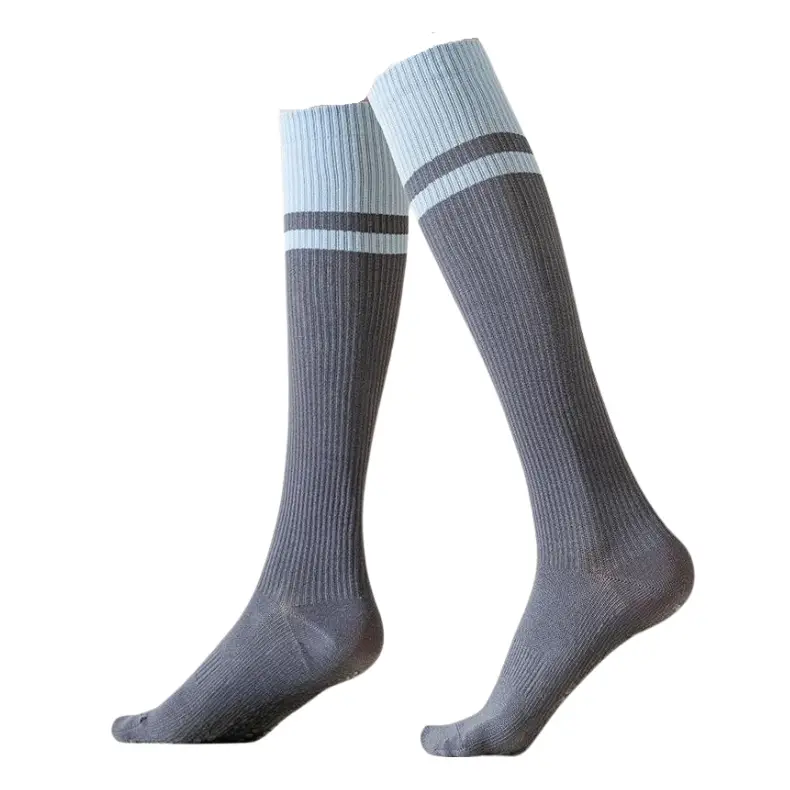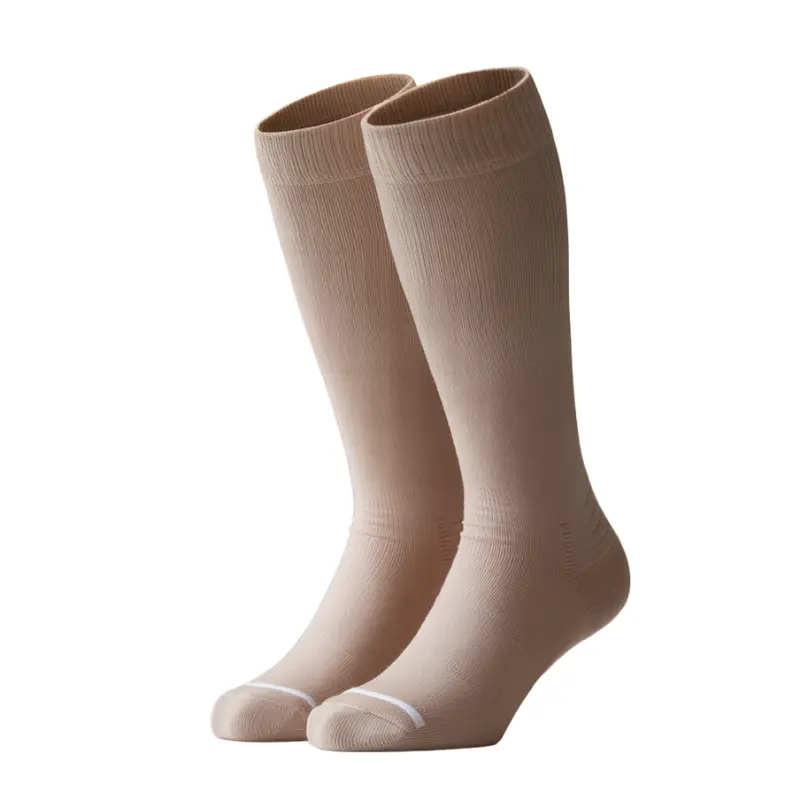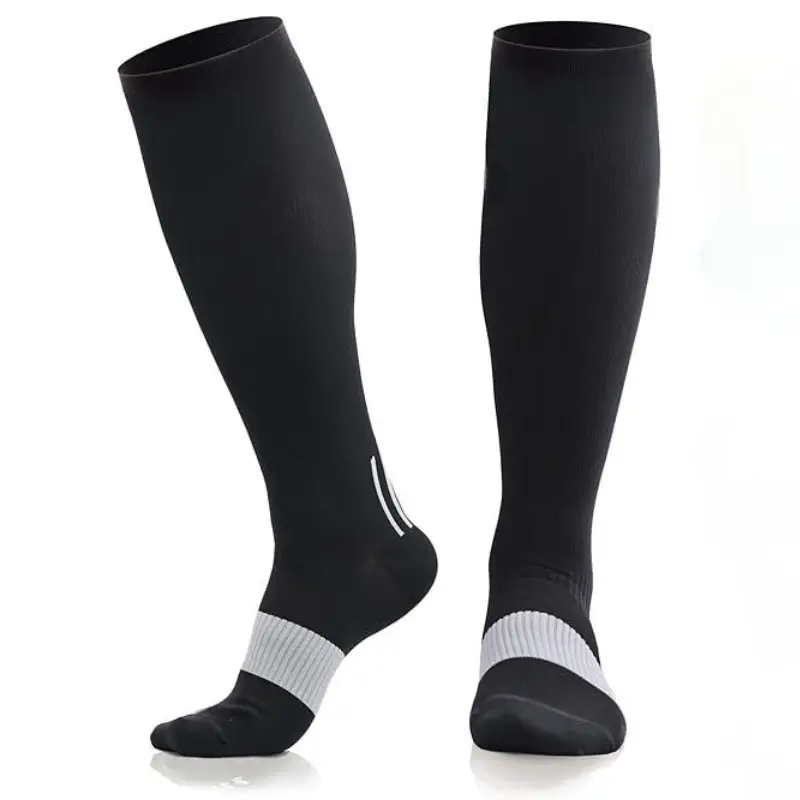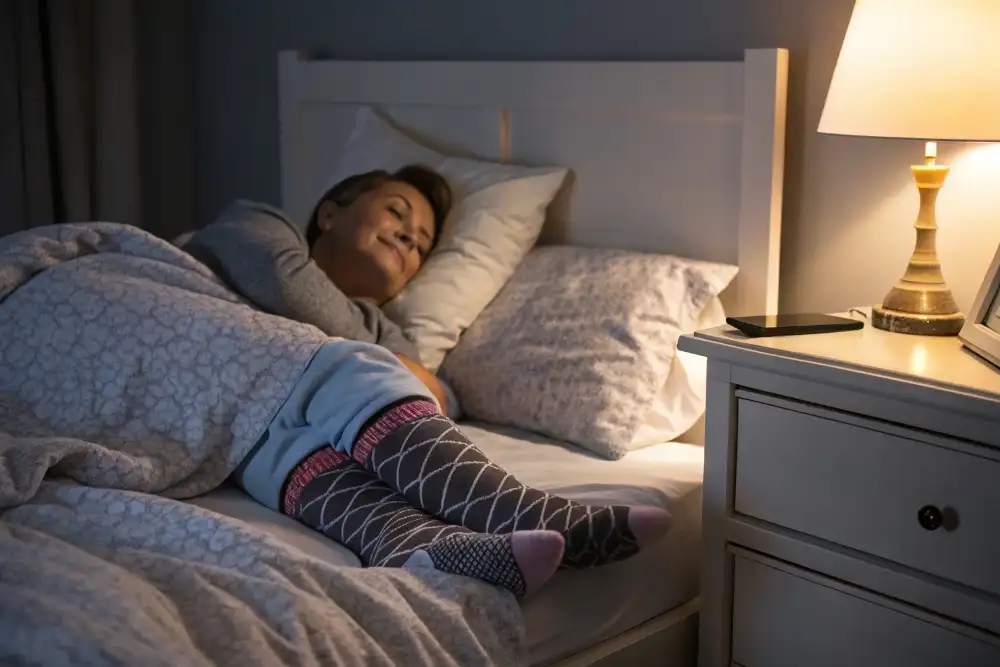Introduction
Many customers are wondering, “Can I wear compression socks to bed?” As a brand or retailer, it’s important to answer this question with confidence and clarity. Compression socks are known for improving circulation and reducing swelling, but what about wearing them overnight? For some, sleeping in compression socks can provide extra relief and help with recovery, but there are also risks to consider.
The global market for compression socks is experiencing significant growth, reflecting a heightened awareness of health and wellness among consumers. In 2024, the market was valued at approximately $1.7 billion and is projected to reach $2.5 billion by 2033, exhibiting a compound annual growth rate (CAGR) of 4.23% during the period from 2025 to 2033. This surge in demand is not limited to healthcare applications; athletes and travelers are increasingly adopting compression socks to enhance performance and comfort.
For most people, wearing compression socks to bed is not recommended. When you are lying flat, your circulatory system doesn’t need help fighting gravity. The unnecessary pressure can potentially cause discomfort or skin irritation. However, you should always follow a doctor’s orders, as they are sometimes prescribed for specific post-surgery or medical conditions.
In this article, we’ll explore the benefits and potential drawbacks of wearing compression socks to bed, and how you can guide your customers to make informed choices. Whether your focus is on health, sports, or comfort, understanding this question will help you better serve your customers and grow your business. Keep reading to learn more!



How Do Compression Socks Work?
Compression socks work by applying more pressure at the ankle and less at the calf. This helps move blood upwards, preventing it from pooling in the lower legs. The pressure is measured in mmHg, with 15-20 mmHg ideal for general use, and 20-30 mmHg recommended for more serious conditions like varicose veins. Understanding these levels allows you to choose the right socks for your customers’ needs.
Benefits of Nighttime Compression Socks: Addressing Customer Pain Points
Relieving Severe Lymphedema and Postoperative Recovery
For individuals with severe lymphedema or those recovering from surgery, wearing compression socks at night can provide valuable support. These socks help maintain circulation while the body is at rest, preventing excess fluid buildup and reducing swelling. This can be particularly beneficial for post-surgery recovery, as stable circulation accelerates the healing process. By offering nighttime options, you can meet the needs of these customers looking for relief and recovery solutions.
Supporting Orthostatic Hypotension and Pregnancy Swelling
Nighttime compression socks can also help people dealing with orthostatic hypotension (a condition where blood pressure drops when standing) by ensuring consistent blood flow. Similarly, pregnant women often experience swelling in their legs, and wearing compression socks overnight can reduce discomfort and improve circulation. These niche solutions help you cater to specific customer concerns and build trust within these specialized groups.
Athlete Recovery: Enhancing Overnight Muscle Repair
Athletes who push their bodies to the limit benefit from wearing compression socks overnight to support muscle repair. By improving circulation during sleep, compression socks help reduce muscle soreness and enhance recovery. This can give athletes a competitive edge, allowing them to perform at their peak. Offering these solutions to fitness brands and sports retailers can tap into the growing market of customers looking for ways to recover faster and improve their performance.
Risks of Overnight Compression Sock Use: Mitigating Customer Complaints
Skin Irritation Pitfalls: Why Breathable Fabrics Matter for Nighttime Wear
While compression socks provide many benefits, wearing them overnight can sometimes cause skin irritation, especially if the fabric isn’t breathable. Customers who experience discomfort may complain about itching, redness, or rashes. To minimize this risk, prioritize socks made from materials that promote airflow, like bamboo fiber or modal. These fabrics not only keep the skin dry but also ensure that your customers remain comfortable through the night, reducing the chances of irritation.
Peripheral Artery Disease Dangers: When Compression Socks Become Harmful
For individuals with peripheral artery disease (PAD), wearing compression socks without proper guidance can lead to more harm than good. The pressure from these socks can worsen circulation issues, causing pain or even tissue damage. It’s essential to educate your customers about when compression socks are appropriate and to advise them to consult a healthcare professional if they have conditions like PAD. By doing so, you can prevent complaints and potential health risks, while ensuring your products are used safely.

Balancing Tightness: Avoiding Numbness, Discoloration, and Customer Returns
One of the common complaints from customers is numbness or discoloration caused by socks that are too tight. When compression socks are not the right fit, they can obstruct circulation rather than support it. Ensuring that the socks fit properly is key to preventing these issues. Offering a range of sizes and emphasizing the importance of accurate measurements can help customers choose the right pair. By addressing these fit concerns upfront, you can reduce the likelihood of customer returns and increase satisfaction.
Who Should (and Shouldn’t) Wear Compression Socks to Bed? Your Retail Guide
Doctor-Recommended Use: Post-Surgery, Venous Ulcers, and Severe Edema
Certain groups benefit greatly from wearing compression socks, especially those with specific health conditions. Individuals recovering from surgery, dealing with venous ulcers, or suffering from severe edema can find relief through the gentle support compression socks provide, promoting circulation and reducing swelling while they sleep. Long-distance travelers also use compression socks to prevent swelling and discomfort during extended periods of sitting.
Red Flags for Customers: Diabetes Complications, Restricted Mobility, or Arterial Issues
Certain health conditions make wearing compression socks to bed not advisable. Customers with diabetes-related complications, peripheral artery disease, or restricted mobility should be cautious, as compression socks can worsen circulation problems in these cases. If your customers have any of these conditions, it’s crucial to advise them to consult a healthcare professional before using compression socks overnight, as improper use can cause more harm than good.
Positioning Daytime vs. Nighttime Socks: Educating End-Users on Proper Usage
Compression socks serve different purposes depending on when they are worn. Daytime socks are generally designed with higher compression levels to support active movement and fight swelling throughout the day. In contrast, nighttime socks typically offer lighter compression for gentle support during rest. It’s important to clearly explain to your customers the difference between these types and guide them on how to use each one appropriately. This ensures they get the best results, whether they’re improving circulation while awake or promoting recovery while sleeping.

How to Choose Compression Socks for Nighttime: Retailer Best Practices
Choosing Low Compression Socks for Comfort and Effectiveness
When selecting compression socks for nighttime use, it’s important to focus on those with low compression levels, typically between 15-20 mmHg. This level provides enough support to improve circulation while sleeping without being too tight or uncomfortable. For your customers, choosing the right compression level ensures they get the benefits of reduced swelling and better blood flow without feeling restricted, allowing them to rest comfortably through the night.
Materials That Enhance Breathability and Skin Comfort
Breathability is a key factor in choosing the right compression socks for nighttime wear. Materials like bamboo fiber, modal, and cotton blends are ideal for ensuring comfort while sleeping. These fabrics are soft, breathable, and moisture-wicking, which helps keep the skin dry and cool. Offering socks made from these materials will improve customer satisfaction by preventing skin irritation and discomfort, making them more likely to return for future purchases.
Finding the Perfect Fit to Prevent Wrinkles and Poor Circulation
The fit of compression socks is crucial, especially for overnight wear. Ill-fitting socks can cause wrinkles or tight spots that interfere with circulation, leading to discomfort and potential health issues. Encourage customers to measure their legs accurately, particularly at their most relaxed state, to ensure the socks fit properly. Offering a variety of sizes and providing clear sizing guides can help customers find the perfect fit, reducing complaints and returns while enhancing their experience with your products.
Precautions Every Brand Must Communicate to Customers
Mandatory Medical Consultations: Building Credibility Through Safety
Before recommending compression socks for nighttime use, it’s important to emphasize the need for medical consultation, especially for customers with existing health conditions. Encouraging your customers to consult a doctor before using compression socks ensures their safety and builds credibility for your brand. This step shows your commitment to their well-being and helps establish trust with your audience, enhancing customer loyalty.
Spotting Adverse Reactions: Numbness, Redness, and “When to Stop” Guidelines
It’s crucial to inform your customers about possible adverse reactions when wearing compression socks. If they experience symptoms like numbness, redness, or discoloration, they should immediately remove the socks and seek medical advice. Providing clear guidelines on when to stop wearing the socks can help prevent potential health risks, ensure a positive experience and reduce customer complaints.
Hygiene Protocols: Daily Sock Changes to Boost Product Turnover
To maintain both comfort and hygiene, customers should be reminded to change their compression socks daily. This not only helps to keep the socks in optimal condition but also encourages more frequent purchases, boosting product turnover. By offering clear recommendations on care and maintenance, you can ensure your customers get the best experience from your products while supporting your business
Partnering With Our Factory: Precision Solutions for Compression Sock Brands
Leverage 18+ years of manufacturing expertise and 8 million pairs annual output to deliver precision-engineered hosiery for lifestyle niches like travel, fitness, or maternity.
- Customized Compression Levels for Diverse Needs: Tailor pressure gradients (15-30 mmHg) to address niche demands.
- Material Innovation for Comfort & Performance: Choose breathable, skin-friendly fabrics (bamboo blends, antimicrobial yarns) to minimize nighttime irritation. Our seamless knitting technology eliminates pressure points, ensuring restful wear.
- Bulk Orders Made Simple: Streamline procurement with pre-sized kits for key markets:
- Travel essentials: Bundled socks with luggage accessories.
- Fitness brands: Performance-focused packs for post-workout recovery.
- Maternity lines: Gentle compression sets for prenatal wellness.
- Certifications Build Consumer Trust: Our FDA and CE certifications validate compliance with global safety standards, reassuring retailers of product reliability.
- Fast Turnaround & Reliable Support: Benefit from rapid sample production (4-7 days) and a 98% defect-free rate. Our team offers responsive communication (<1 hour) and end-to-end logistics to accelerate your market entry.
- Stand Out with Bespoke Branding: Customize packaging, sock designs (patterns, logos), and promotional materials to align with your brand identity.
Learn more about custom compression socks.
Conclusion: Helping Customers Sleep Smarter with Compression Socks
Compression socks can offer meaningful nighttime relief—but only when chosen and worn correctly. Brands should guide customers by highlighting when overnight use is helpful, such as for recovery, swelling, or travel, while clearly communicating risks for certain conditions. Prioritizing breathable materials, low compression levels, and proper fit is key to customer comfort and safety.
Want to deliver trusted compression solutions tailored for night use?
Contact Max Hosiery today for custom compression sock development that meets wellness, safety, and market demands—backed by expert manufacturing and responsive support.
Retailer FAQs About Nighttime Compression Socks
Can compression socks replace prescribed medical treatments?
Compression socks are not a replacement for prescribed medical treatments. They help with circulation and swelling but should be used alongside medical advice, especially for conditions like deep vein thrombosis or lymphedema. Always recommend consulting a healthcare professional.
How to market nighttime socks to pregnant customers?
For pregnant customers, emphasize how compression socks help with swelling, fatigue, and discomfort. Focus on the benefits of better circulation and comfort, especially at night. Offer breathable fabrics and adjustable sizes to enhance comfort for pregnant women.
What certifications should factory-partnered compression socks have?
Compression socks should have certifications like CE for safety and compliance with European standards and FDA approval for medical-grade products. Look for material certifications like OEKO-TEX Standard 100, ensuring fabrics are safe and free from harmful substances.
How do you ensure the quality of your compression socks for nighttime use?
We perform rigorous quality checks during production, including fabric testing, compression measurement, and fit testing to ensure the socks meet the required standards for both comfort and functionality.
What should my customers know before offering compression socks for nighttime use?
It’s important to educate customers on the benefits, risks, and ideal candidates for overnight wear. We also recommend advising them to consult a healthcare professional if they have underlying conditions that may affect circulation, like diabetes or peripheral artery disease.
